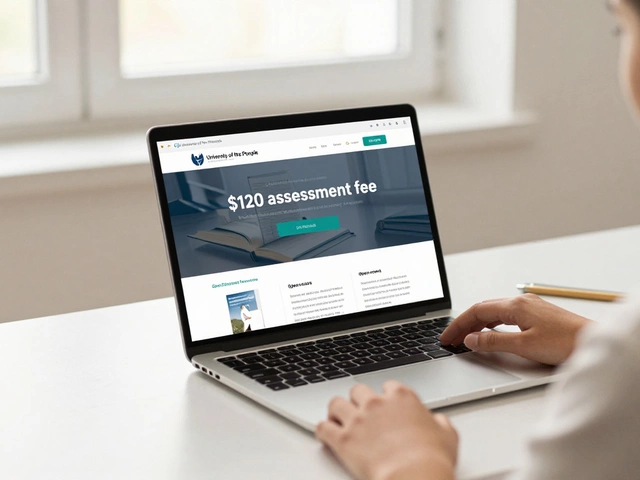Feb
5

- by Dhruv Ainsley
- 0 Comments
Picking the right online teaching platform isn't just about clicking a button and signing up. It's like shopping for a new car—there's a lot to consider beyond just 'will it get me from A to B?' You'll want to look at the features, user experience, and price tag, sure, but what about the stuff that really matters, like how easy is it to engage students or manage coursework?
Imagine this: You're ready to teach about the wonders of the solar system. Do you need robust video conferencing or would a simple discussion board do the trick? What about quizzes, grades, and tracking student progress? The features vary a lot from platform to platform, so having a good grasp of what you need is key.
Then there's the user experience. You don't want to be wrestling with tech issues while your students fall asleep, right? That's why it's crucial to pick something intuitive and easy to navigate. And hey, don't just go for the big names. Sometimes, the underdogs offer surprises that make teaching and learning a breeze.
- Overview of Online Teaching Platforms
- Key Features to Look For
- Top Platforms Compared
- User Experience and Accessibility
- Cost and Value for Money
Overview of Online Teaching Platforms
When it comes to online teaching, there's a smorgasbord of platforms out there, each with its own set of bells and whistles. From giants like Coursera and Udemy to niche players like Teachable and Kajabi, the options can be overwhelming. So, how do you know which one hits the mark for your e-learning adventure?
Variety of Platforms
The e-learning landscape isn't one-size-fits-all. You’ve got platforms like Udemy, which is all about massive open online courses (MOOCs) that cater to lifelong learners looking to pick up new skills. For a more structured classroom feel, you’ve got Coursera partnering with leading universities to offer credentialed courses.
Then there's Teachable and Kajabi, which are perfect if you want to create your own course from scratch and sell it. Unlike the MOOC giants, these platforms give you freedom in design and pricing, making them ideal for entrepreneurs and educators wanting to build their own brand.
What Do These Platforms Offer?
Most of these platforms share some core features but also have unique selling points. Here's a quick summary:
- Udemy: Great for reaching a broad audience, but you’ll be competing with tons of other courses.
- Teachable: Offers excellent tools for personal branding and marketing.
- Coursera: Best for those who want to offer serious academic credentials and courses backed by universities.
- Kajabi: Provides a full-service suite for course creation, marketing, and analytics.
While these platforms provide ample support to get you started, keep an eye out for key differentiators like ease of use, flexibility in curriculum design, and the ability to integrate with third-party tools.
Integration and Accessibility
It's not just about the courses themselves—think about how these platforms integrate with tools you're already using. Do they mesh with Zoom for live sessions? Can you plug in Google Analytics to track engagement? Accessibility is key, so choose a platform that allows easy syncing with your favorite digital tools.
Plus, consider mobile accessibility. With students and educators on the go, a platform that offers a seamless experience on smartphones or tablets can be a game-changer.
| Platform | Price Range | Popular Features |
|---|---|---|
| Udemy | Courses from $10 to $200 | Wide Range of Topics, Self-Paced Learning |
| Teachable | $29 to $399/month | Custom Branding, Easy Course Building |
| Coursera | Free to $79/month | Certificates, University Backing |
| Kajabi | $119 to $319/month | Email Marketing, In-depth Analytics |
In a nutshell, the perfect platform boils down to your goals. Are you trying to reach the masses, or are you keen on building a personalized course experience? Identifying your priorities will help narrow down your options and set you on the right path to effective online teaching.
Key Features to Look For
When evaluating e-learning platforms for online teaching, there are a few must-haves that can really boost your teaching game. These features might seem straightforward, but they make a world of difference when it comes to delivering effective education.
1. User-Friendly Interface
First up, you'll want a platform that's not going to make your head spin with technical jargon. Think of platforms like Zoom or Google Classroom—they're straightforward to use and don't need an IT degree to navigate. A friendly interface means less time clicking around and more time actually teaching.
2. Interactive Tools
Good online teaching isn’t just about talking to a screen. Look for platforms that offer interactive tools, like quizzes, polls, or whiteboards. Kahoot! and Nearpod are great examples where student interaction can turn a boring lecture into a lively discussion.
3. Analytics and Progress Tracking
Having the ability to track student progress can save you a ton of hassle. Platforms like Moodle and Blackboard offer robust analytics to see who's acing the material and who might need extra help. This feature is a game-changer for personalizing learning experiences.
4. Content Management
You'll need a solid way to upload and organize all your learning materials. A *good content management system (CMS)* ensures your materials are easily accessible and well-organized. Canvas is one platform that really shines in this area, offering seamless management of assignments, videos, and documents.
5. Scalability and Flexibility
Lastly, consider how well the platform scales. If you're planning to grow your student numbers or expand your course offerings, scalability is key. Platforms like Teachable and Thinkific excel due to their ability to handle anything from solo tutors to full-scale educational institutions.
Some Stats to Consider
| Platform | User Satisfaction (%) |
|---|---|
| Zoom | 85 |
| Google Classroom | 80 |
| Moodle | 78 |
By keeping these features in mind, you're setting yourself up for a smoother teaching experience. Whether it's through enhanced interaction or better content organization, the right platform features can make a significant impact.

Top Platforms Compared
When it comes to choosing the right e-learning platform, it’s really about what fits your needs best. Let's look at some of the top contenders in the industry and see what they offer.
1. Coursera
Coursera has been a big player for years now, teaming up with universities around the world. The big win here is their access to courses designed by top institutions. You can even get certificates or degrees that carry weight in the professional world. But with premium content comes premium prices.
- Pros: High-quality courses, recognized certifications, great for formal education.
- Cons: Can be expensive, not customized for every niche.
2. Udemy
Udemy's approach is a lot more DIY. Anyone can create a course, which means you get a huge variety but also varied quality. It’s affordable, with courses often on discount, plus you can find something for every interest, from business to knitting.
- Pros: Massive course selection, frequent sales, flexibility.
- Cons: Quality can vary, may lack in-depth academic rigor.
3. Skillshare
If you’re looking to dive into creative skills, Skillshare might be your go-to. It’s subscription-based, giving you access to a wide array of classes, often with a focus on practical, project-based learning. Perfect if you're a creative soul or looking to pick up a new hobby.
- Pros: Emphasizes creativity, community-driven, project-oriented.
- Cons: Less traditional, non-accredited.
4. Teachable
Teachable is for educators or entrepreneurs who want to create and sell their courses. It's user-friendly and offers great tools for monetization, including integration with payment processors. But you’ve got to do most of the marketing yourself.
- Pros: Great for course creation, robust tools, easy to brand.
- Cons: Marketing relies on you, can be costly to set up.
Comparison Table
| Platform | Best For | Pricing |
|---|---|---|
| Coursera | Higher education, credentials | High |
| Udemy | Varied interests, self-paced | Low-Medium |
| Skillshare | Creative skill-building | Subscription |
| Teachable | Course creators | Varies |
Picking a platform boils down to matching their strengths with your goals. Whether it's getting a degree, learning at your pace, unleashing creativity, or offering your own courses, there's a platform out there for you.
User Experience and Accessibility
Ever felt frustrated when using a website because you can't find that button you need? Imagine the headache for educators or students facing a poorly designed e-learning platform. That's why user experience (UX) is a big deal. A platform should be your silent partner, not your biggest problem.
Easy to Navigate
First thing's first, the interface should be intuitive. Think of it like a GPS; it guides you where you need to go without making you take a wrong turn. Businesses like Google Classroom and Zoom have nailed this by making their platforms straightforward and clutter-free. No one has time to read a user's manual; they need a smooth ride.
Accessibility for Everyone
What good is a teaching platform if not everyone can use it? Accessibility means the world to students with disabilities or those using different technologies. Platforms like Microsoft Teams and Moodle are leading the charge, offering features like screen readers and keyboard shortcuts. These may sound simple, but they open doors for many learners.
Check this out: a study revealed that 71% of students with disabilities face barriers with digital content. That's where choosing the right platform makes a difference; it can empower ALL students to excel.
Device Compatibility
Think about how many different gadgets people use today. From laptops to tablets, and smartphones, every student or educator has their preference. The best platforms ensure seamless performance on any device. Schoology, for example, has earned praise for its user-friendly mobile app, which means you can learn or teach even when stuck in line for coffee.
Global Reach
In our diverse world, language and regional compatibility are essential. Offering multiple language options can transform your platform from a local hero to a global superstar. Few platforms reach this level, but those like Blackboard and Canvas offer variations to meet global needs, enhancing the online teaching experience.
When considering user experience and accessibility, it's all about removing barriers, increasing comfort, and boosting engagement. Online teaching should feel natural, enabling a rich and inclusive learning environment for everyone.

Cost and Value for Money
When it comes to online teaching platforms, you're gonna want to balance cost with what you're actually getting out of it. It's like buying coffee—you could go anywhere, but are you getting that silky, smooth latte you love or something closer to instant coffee?
First up, let's talk free versus paid options. Platforms like Zoom offer basic video conferencing capabilities at no cost, which might be all you need if your classes are straightforward chats and lessons. But if you want more, like recorded sessions or breakout rooms, you’ll probably need to shell out some cash.
What Are You Paying For?
The price you see can depend heavily on features. Think about how important things like customization, analytics, and integration are for you. You might find that a higher upfront cost could mean savings down the road by streamlining your workload.
Comparing the Popular Choices
- Moodle: Known for being budget-friendly with a lot of flexibility, especially if you're a bit tech-savvy. But set aside time for setup.
- Teachable: This is great if you're selling courses. They take a percentage of sales if you're on their free plan, but the paid options can help if you're growing your business.
- Udemy: More like a marketplace. There's no upfront cost for instructors, but they take a chunk of your earnings—think around 50% if you don’t bring the students yourself.
Hidden Costs to Watch For
Don't overlook additional costs like payment processing fees, especially if you're using platforms to sell courses. Also, consider any integrations you may need, like CRM systems or email marketing tools—they can add to your monthly expenses.
Here's a quick glance at the potential costs:
| Platform | Basic Monthly Cost | Transaction Fee |
|---|---|---|
| Teachable | $29 | 5% + payment fees |
| Udemy | Free for instructors | 50% split if Udemy recruits students |
| Zoom | 0 to $20 | None for basic use |
Remember, the best platform isn't always the cheapest one. It's about finding that sweet spot where cost meets your needs and helps you achieve your e-learning goals without breaking the bank.





